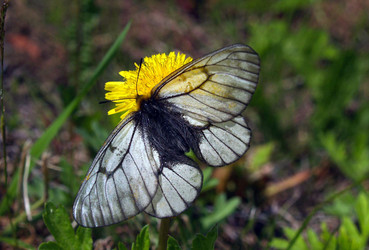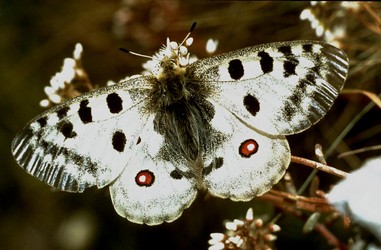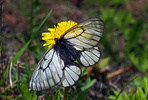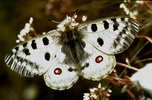Parnassius
Vazrick Nazari


This tree diagram shows the relationships between several groups of organisms.
The root of the current tree connects the organisms featured in this tree to their containing group and the rest of the Tree of Life. The basal branching point in the tree represents the ancestor of the other groups in the tree. This ancestor diversified over time into several descendent subgroups, which are represented as internal nodes and terminal taxa to the right.

You can click on the root to travel down the Tree of Life all the way to the root of all Life, and you can click on the names of descendent subgroups to travel up the Tree of Life all the way to individual species.
For more information on ToL tree formatting, please see Interpreting the Tree or Classification. To learn more about phylogenetic trees, please visit our Phylogenetic Biology pages.
close boxPhylogeny after Omoto et al. (2004) based on mitochondrial ND5 gene (777 bp, maximum parsimony). The tree shown here is better resolved and encompasses a larger number of species compared to the phylogeny proposed by Katoh et al. (2005) based on ND1 and 16S, which also has a somewhat different topology.
Introduction
Having received tremendous attention from both collectors and taxonomists, Parnassius butterflies are among the most well studied butterflies in alpine zones. The region of greatest diversity of Parnassius is the eastern Palaearctic, from Pakistan to central Asia and China. A few species extend as far as Europe, Japan, and into the Nearctic (Weiss, 1991, 1995).
The caterpillars of Parnassius, like other swallowtails, possess the peculiar structure known as an osmeterium at the back of their head. They feed on various members of Crassulaceae and Papaveraceae. Isolation of Parnassius populations in various mountain ranges has resulted in differentiation and subsequent description of numerous subspecies, varieties and forms (e.g. Bryk, 1935).
Many detailed books and checklists have been published on the taxonomy of Parnassius (e.g. see Weiss, 1991-2005; Tshikolovets, 1998-2003); these books usually offer high quality images and color maps, and illustrate a substantial range of morphological variability for many of the species of Parnassius.
Conservation
Some European countries have local regulations protecting their Parnassius species (P. mnemosyne, P. phoebus and P. apollo) (Collins and Morris, 1985). The well-known species, P. apollo, is extinct in some European countries but is relatively common in other parts of its range. It is the only species covered by CITES, despite the fact that numerous other species of Parnassius are in need of immediate attention (Collins and Morris, 1985).
Even the more common Parnassius species in Asia comprise many local subspecies and distinct populations, many of which are extremely vulnerable and on the verge of extinction. Some highly endangered Parnassius include P. arcticus, P. ariadne, P. boedromius, P. cardinal, P. felderi, P. loxias, P. patricius, P. simo, P. simonius, and nearly all Tibetan species; some of these species are listed in Red Data Books for Russia, Yakutia or Tajikistan (Dinets, 2002). Many species are known from only a few specimens, and several have been rare in collection for decades, including Parnassius autocrator which inhabits the northern part of the Hindukush district in Afghanistan and Tajikistan (Weiss, 1991).
Discussion of Phylogenetic Relationships
Two molecular studies have been published on the phylogeny of the genus Parnassius (Omoto et al., 2004; Katoh et al., 2005). Omoto et al. looked at 777 bp of the mitochondrial ND5 gene in a large number of Parnassius speicies, and Katoh et al. used mitochondrial 16S ribosomal RNA (504 bp) and NADH dehydrogenase subunit 1 (469 bp) in a smaller number of species. Both of these studies recover several well-supported clusters of species-groups that to some degree correspond to those previously recognized based on morphological characters (e.g. Hancock, 1983), but fail to resolve the deeper phylogenetic relationships among them.
Taxonomy
Despite growing interest, the exact number of “species” within Parnassius remains disputed, as more recent checklists present conflicting numbers, ranging from 38 (UNEP-WCMC, 2006) to 47 (Weiss 1991). Many of these species, however, are morphologically very similar.
Eight subgenera are generally recognized within Parnassius, as follows (in chronological order; from Bryk, 1935; Häuser et al., 2005; Savela, 2005):
- Subgenus Parnassius Type species: Papilio apollo
- Subgenus Koramius Type species: Parnassius delphius
- Subgenus Tadumia Type species: Papilio acco
- Subgenus Kailasius Type species: Parnassius charltonius
- Subgenus Eukoramius Type species: Parnassius imperator
- Subgenus Lingamius Type species: Parnassius hardwickii
- Subgenus Driopa Type species: Papilio mnemosyne
- Subgenus Sachaia Type species: Parnassius tenedius
All of these genus-level names, together with a few others that are generally overlooked (e.g. Erythrodriopa Korshunov, 1988; Adoritis Koçak, 1989; Quinhaicus Korshonov, 1990, and Kreizbergius Korshunov, 1990), have been synonymized with Parnassius (Munroe, 1961; Hesselbarth et al., 1995), although they are still used to designate “species-groups” within the genus (Omoto et al., 2004; Häuser et al., 2005). More recent treatments are confined to grouping Parnassius species under a number of species-groups that may not correspond to the subgeneric classification (Weiss, 1991-2005; Tshikolovets, 1998-2003). The number of species included in each of these subgenera (or species-groups) varies in checklists (e.g. see Bryk, 1935; Häuser et al., 2005).
References
Bryk, F., 1935. Parnassiinae Part II. Das Tierreich, Deutschen Zoologische Gesellschaft im Auftrag der Preussischen Akademie der Wissensch. Berlin und Lepizig, 65: I-LI, 1-790.
Collins, N.M., Morris, M.G., 1985. Threatened Swallowtail Butterflies of the World: The IUCN Red data book. Gland, Switzerland. 401 pp.
Dinets, V., 2002. Vladimir Dinets home page. Accessed December 2005.
Häuser, C.L., de Jong, R., Lamas, G., Robbins, R.K., Smith, C., Vane-Wright, R.I., 2005. Papilionidae – revised GloBIS/GART species checklist (2nd draft). Accessed December 2005.
Hesselbarth, G., van Oorschot, H., Wagener, S., 1995. Die Tagfalter der Türkei. 1. 754 pp. Bocholt, Selbstverlag Sigbert Wagener.
Katoh, T., Chechvarkin, A., Yagi, T., Omoto, K., 2005. Phylogeny and evolution of butterflies of the genus Parnassius: Inferences from mitochondrial 16S and ND1 sequences. Zoological Science 22: 343-351.
Munroe, E., 1961. The classification of the Papilionidae (Lepidoptera). The Canadian Entomologist Supplement 17: 1-51.
Omoto, K., Katoh, T., Chichvarkhin, A., Yagi, T., 2004. Molecular systematics and evolution of the 'Apollo' butterflies of the genus Parnassius (Lepidoptera: Papilionidae) based on mitochondrial DNA sequence data. Gene 326: 141-147.
Savela, M., 2005. Lepidoptera and some other life forms. Accessed December 2005.
Tshikolovets, V.V., 1998. The Butterflies of Turkmenistan. Kyiv, Brno, 237 pp.
Tshikolovets, V.V., 2000. The Butterflies of Uzbekistan. Kyiv, Brno, 400 pp.
Tshikolovets, V.V., 2003. The Butterflies of Tajikistan. Kyiv, Brno, 500 pp.
UNEP-WCMC species database, 2006. Accessed January 2006.
Weiss, J.C., 1991. The Parnassiinae of the World. Part 1. Sciences Nat, Venette, France. p. 1-48.
Weiss, J.C., 1992. The Parnassiinae of the World. Part 2. Sciences Nat, Venette, France. p. 49-136.
Weiss, J.C., 1999. The Parnassiinae of the World. Part 3. Hillside Books, Canterbury, U.K., p. 137-236.
Weiss, J.C., 2005. The Parnassiinae of the World. Part 4. Hillside Books, Canterbury, U.K., p. 237-400.
Title Illustrations

| Scientific Name | Parnassius glacialis |
|---|---|
| Location | Morioka, Iwate, Tohoku, Japan |
| Specimen Condition | Live Specimen |
| Source | Parnassius glacialis - 2 - ウスバシロチョウ |
| Source Collection | Flickr |
| Image Use |
 This media file is licensed under the Creative Commons Attribution-NonCommercial-NoDerivs License - Version 2.0. This media file is licensed under the Creative Commons Attribution-NonCommercial-NoDerivs License - Version 2.0.
|
| Copyright | © 2006 Bruce the Moose |
| Scientific Name | Parnassius apollo |
|---|---|
| Specimen Condition | Live Specimen |
| Source | Apollo_F_1 |
| Source Collection | Flickr |
| Image Use |
 This media file is licensed under the Creative Commons Attribution-NonCommercial-NoDerivs License - Version 2.0. This media file is licensed under the Creative Commons Attribution-NonCommercial-NoDerivs License - Version 2.0.
|
| Copyright | © 2008 Jürgen Mangelsdorf |
About This Page
Vazrick Nazari

Canadian National Collection of Insects, Arachnids and Nematodes, Ottawa, Canada
Correspondence regarding this page should be directed to Vazrick Nazari at
nvazrick@yahoo.com
Page copyright © 2006 Vazrick Nazari
 Page: Tree of Life
Parnassius .
Authored by
Vazrick Nazari.
The TEXT of this page is licensed under the
Creative Commons Attribution License - Version 3.0. Note that images and other media
featured on this page are each governed by their own license, and they may or may not be available
for reuse. Click on an image or a media link to access the media data window, which provides the
relevant licensing information. For the general terms and conditions of ToL material reuse and
redistribution, please see the Tree of Life Copyright
Policies.
Page: Tree of Life
Parnassius .
Authored by
Vazrick Nazari.
The TEXT of this page is licensed under the
Creative Commons Attribution License - Version 3.0. Note that images and other media
featured on this page are each governed by their own license, and they may or may not be available
for reuse. Click on an image or a media link to access the media data window, which provides the
relevant licensing information. For the general terms and conditions of ToL material reuse and
redistribution, please see the Tree of Life Copyright
Policies.
- First online 07 July 2006
- Content changed 07 July 2006
Citing this page:
Nazari, Vazrick. 2006. Parnassius . Version 07 July 2006 (under construction). http://tolweb.org/Parnassius/65393/2006.07.07 in The Tree of Life Web Project, http://tolweb.org/









 Go to quick links
Go to quick search
Go to navigation for this section of the ToL site
Go to detailed links for the ToL site
Go to quick links
Go to quick search
Go to navigation for this section of the ToL site
Go to detailed links for the ToL site